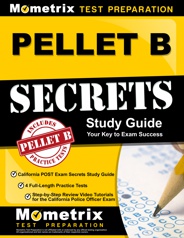If you are applying to law enforcement or if you are in law enforcement in the state of California, you may be required to take the California POST exam. The California POST exam is used to measure the reading and writing skills of those who want to become peace officers.
Click “Start Test” above to take a free California POST practice test!
California POST Exam Outline
The California POST exam, also called the POST Entry-Level Law Enforcement Test Battery (PELLETB), contains 65-78 questions and has a time limit of 2.5 hours. Some questions are multiple-choice, while other questions are fill-in-the-blank.
The exam is split into two categories:
1. Writing Ability (45-54 questions)
There are three subtests in this category, each containing 15-18 questions.
In this subtest, you will be given a sentence and asked to find common writing errors within the sentence. The errors you might be asked to find include sentence fragments, run-on sentences, subject-verb agreement, and misplaced modifiers.
Spelling
In this subtest, you will be given a sentence that has one word removed and replaced by a blank line. You will be given four spellings of the missing word and asked to choose which one is spelled correctly given the context of the sentence.
Vocabulary
In this subtest, you will be given a sentence in which one word is underlined. You will be given four words and asked to select the word that is the closest synonym to the underlined word in the sentence.
2. Reading Ability (20-24 questions)
This category contains only one subtest. The Reading Comprehension subtest contains 20-24 multiple-choice questions.
In this subtest, you will be given passages to read, and you will be asked to answer multiple questions about each passage. The passages will vary in length from one paragraph to an entire page, and all of the information you need to answer the questions can be found in the applicable passage.
Check Out Mometrix's PELLETB Study Guide
Get practice questions, video tutorials, and detailed study lessons
Get Your Study Guide

PELLETB Test Online Prep Course
If you want to be fully prepared, Mometrix offers an online PELLETB prep course designed to give you everything you need to succeed!
Here’s what you’ll find in the PELLETB course:
- 20+ Review Lessons Covering Every Topic
- Over 500 PELLETB Practice Questions
- 20+ Video Tutorials
- Money-back Guarantee
- Mobile Access
Everyone learns differently, so we’ve tailored the PELLETB online prep course to ensure every learner has what they need to prepare for the PELLETB exam.
Click below to check it out!
Registration
To register for the POST exam, you need to contact the law enforcement agency or the basic training academy in your area. The agency may refer to this examination as the POST Reading and Writing Test or the PELLETB test.
Fees
There is no fee for the POST exam. There are fees if you request expedited shipping of your test results.
Scoring
The POST exam takes the number of correct answers on your exam (the raw score) and converts it into a T-score. T-scores are standardized scores that compare the results on a bell-shaped curve indicating average, above-average, and below-average results.
To pass the POST exam, you want to achieve a score that is at least average. On the T-score scale, the range is one to one hundred. Fifty is the midpoint and is considered average.
When the exam has been graded, a deviation of ten is allowed. If you make it within ten points of fifty you will be considered to have an average score.
The POST exam results are given to the agencies or academies that use the exam. These agencies or academies are required to provide the candidates with their examination results within thirty days of the exam date.
Study Tips
How to Study Effectively
Your success on POST test day depends not only on how many hours you put into preparing but also on whether you prepared the right way. It’s good to check along the way to see whether your studying is paying off. One of the most effective ways to do this is by taking POST practice tests to evaluate your progress. Practice tests are useful because they show exactly where you need to improve. Every time you take a free POST exam practice test, pay special attention to these three groups of questions:
- The questions you got wrong
- The ones you had to guess on, even if you guessed right
- The ones you found difficult or slow to work through
This will show you exactly what your weak areas are and where you need to devote more study time. Ask yourself why each of these questions gave you trouble. Was it because you didn’t understand the material? Was it because you didn’t remember the vocabulary? Do you need more repetitions on this type of question to build speed and confidence? Dig into those questions and figure out how you can strengthen your weak areas as you go back to review the material.
Answer Explanations
Additionally, many POST practice tests have a section explaining the answer choices. It can be tempting to read the explanation and think that you now have a good understanding of the concept. However, an explanation likely only covers part of the question’s broader context. Even if the explanation makes sense, go back and investigate every concept related to the question until you’re positive you have a thorough understanding.
Comprehend Each Topic
As you go along, keep in mind that the POST practice test is just that: practice. Memorizing these questions and answers will not be very helpful on the actual test because it is unlikely to have any of the same exact questions. If you only know the right answers to the sample questions, you won’t be prepared for the real thing. Study the concepts until you understand them fully, and then you’ll be able to answer any question that shows up on the test.
Strategy for POST Practice
When you’re ready to start taking practice tests, follow this strategy:
- Remove Limitations. Take the first test with no time constraints and with your notes and POST study guide handy. Take your time and focus on applying the strategies you’ve learned.
- Time Yourself. Take the second practice test “open book” as well, but set a timer and practice pacing yourself to finish in time.
- Simulate Test Day. Take any other practice tests as if it were test day. Set a timer and put away your study materials. Sit at a table or desk in a quiet room, imagine yourself at the testing center, and answer questions as quickly and accurately as possible.
- Keep Practicing. Keep taking practice tests on a regular basis until you run out of practice tests or it’s time for the actual test. Your mind will be ready for the schedule and stress of test day, and you’ll be able to focus on recalling the material you’ve learned.
FAQs
Q
Can I take the POST exam on a computer?
A
Currently, the only format you can take the exam in is paper-and-pencil.
Q
How many questions are on the POST exam?
A
There are between 65 and 78 questions on the exam.
Q
How long is the POST exam?
A
The time limit for the exam is 2.5 hours.
Q
What types of questions are on the POST exam?
A
There are two question types on the exam: multiple-choice and fill-in-the-blank.
Q
What is the passing score for the POST exam?
A
There is no set passing score for the exam, but a score of at least 42 is considered a good score to shoot for.
Q
How much does the POST exam cost?
A
There is no exam fee for this exam.


